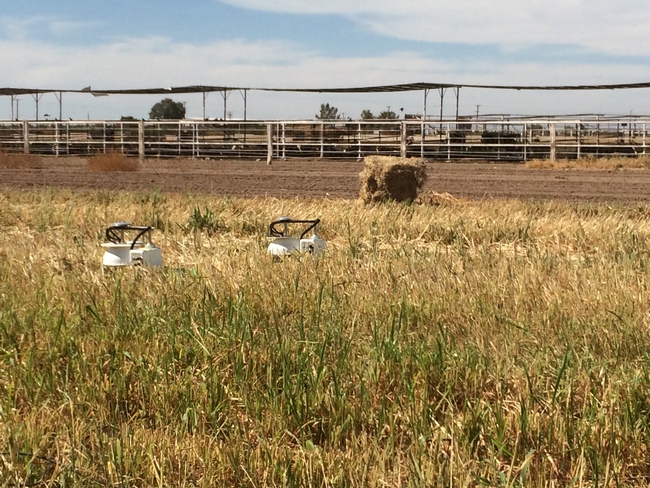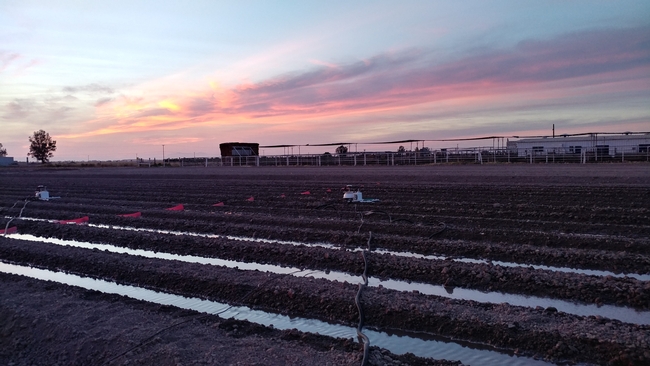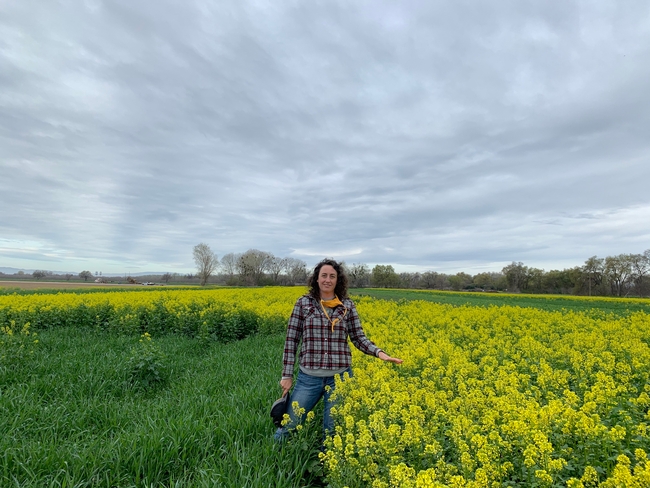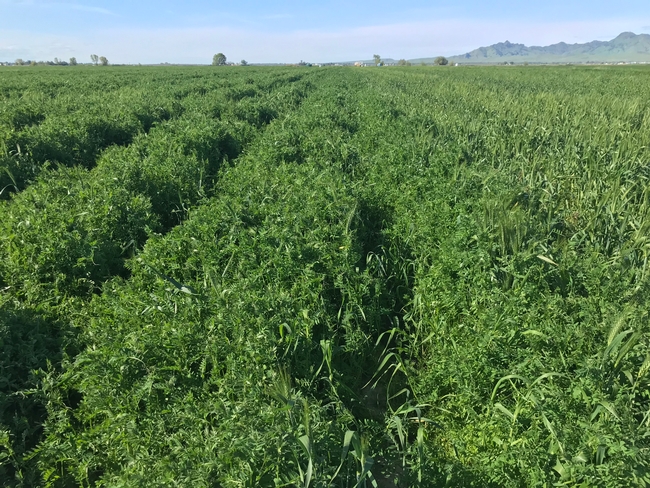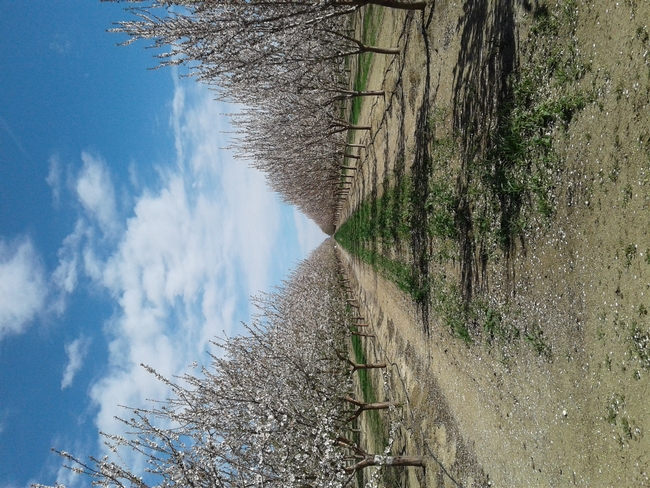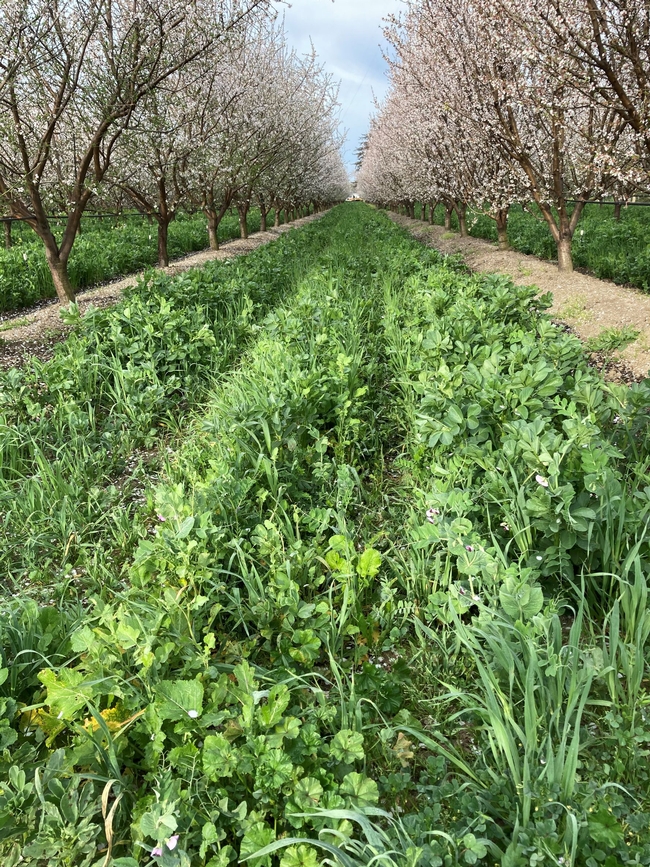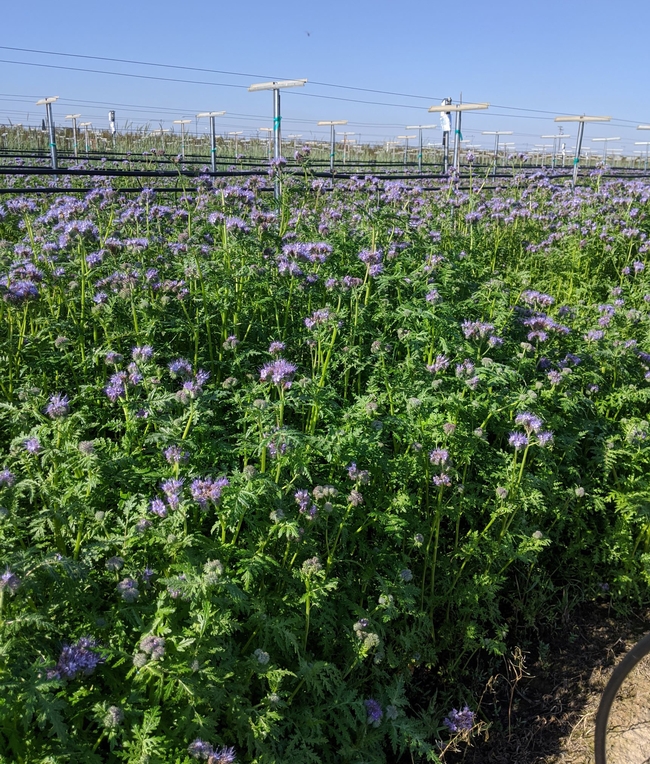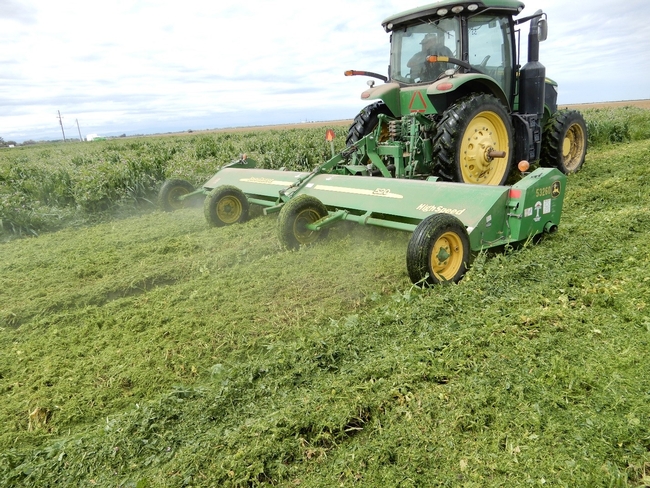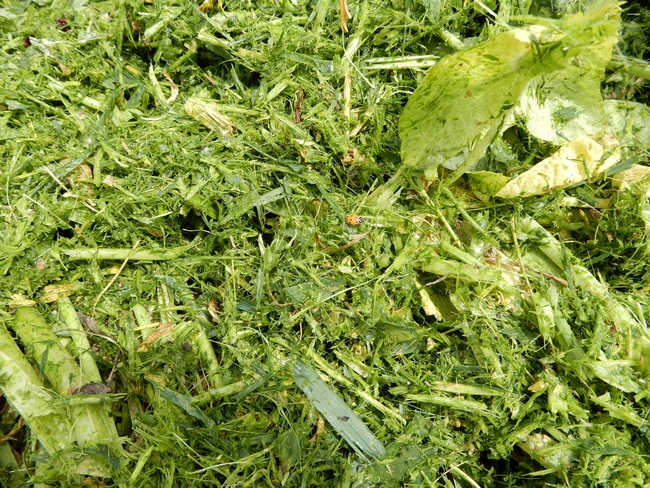Posts Tagged: crops
Drip irrigation in arid regions can cut greenhouse gas emissions, improve air quality
Study at Desert Research and Extension Center highlights agriculture's sustainability role
Under the blistering sun of Southern California's Imperial Valley, it's not surprising that subsurface drip irrigation is more effective and efficient than furrow (or flood) irrigation, a practice in which up to 50% of water is lost to evaporation.
But a recent study also concludes that drip irrigation can dramatically reduce greenhouse gas emissions from soil – which contribute to climate change and unhealthy air quality in the region – without sacrificing yields of forage crops alfalfa and sudangrass.
“It was really exciting to see,” said lead author Holly Andrews, a National Science Foundation postdoctoral fellow at the University of Arizona. “The crop yield was at least maintained and in some cases increased, but the water use and gaseous emissions were especially decreased under drip irrigation.”
Desert REC crucial to collecting data
Andrews and her colleagues gathered data from field studies at University of California Agriculture and Natural Resources' Desert Research and Extension Center, a crucial hub of desert agriculture research for more than 100 years. Studies in that context are increasingly important, as much of California and the Southwest becomes hotter and drier.
“We already have this history of looking at drip irrigation at this site, so our study was trying to build on that,” said Andrews, who lauded Desert REC's facilities and staff.
In their study published in Agriculture, Ecosystems & Environment, researchers found that – in comparison to furrow irrigation – drip irrigation in alfalfa slashed per-yield soil carbon dioxide emissions by 59%, nitrous oxide by 38% and nitric oxide by 20%.
Nitrous oxide is a greenhouse gas with nearly 300 times more warming potential as carbon dioxide, and nitric oxide is a precursor to ozone and major contributor to air pollution.
While drip irrigation only decreased water demand 1% in alfalfa, the practice led to a substantial 49% decrease in irrigation for sudangrass. For more fertilizer-intensive sudangrass, drip irrigation also reduced soil emissions of nitrous oxide by 59% and nitric oxide by 49% – the result of drip irrigation making those fertilizers more efficient.
Water management can help mitigate climate change
Studying alfalfa and sudangrass – forage crops with very different fertilizer requirements – was a strategic choice by the researchers. They are number one and number three on the list of most widely grown crops by acreage in the Imperial Valley (Bermudagrass, another forage crop, is number two).
With so much land dedicated to producing these crops, the adoption of drip irrigation at scale could deliver significant benefits to residents' health and quality of life.
“The thought that saving water can increase yields while lowering the emission of trace gases that affect regional air quality and Earth's climate is quite encouraging,” said Pete Homyak, an assistant professor of environmental sciences at UC Riverside who contributed to the study. “This is especially true for the Imperial Valley, an arid region where water is a limited resource and where residents are exposed to bad air quality.”
Homyak, who is affiliated with UC ANR through UC Riverside's Agricultural Experiment Station, said that this study illustrates how changes in water management can substantially mitigate agricultural impacts on the environment.
The study findings should encourage growers to replace furrow irrigation systems with drip irrigation infrastructure – especially in combination with financial incentives from the state, such as cap-and-trade and carbon credit programs, that can help defray high installation costs.
“It really is worthwhile if you're thinking sustainability and environmental activism in how agriculture can actually support climate change mitigation,” Andrews explained. “These practices might be a way that we can start to change that picture a little bit – and make agriculture more sustainable by tailoring irrigation management to local climate conditions.”
In addition to Andrews and Homyak, the other study authors are Patty Oikawa, California State University, East Bay; Jun Wang, University of Iowa; and Darrel Jenerette, UC Riverside.
Farmers invited to tour cover crops in Sacramento Valley March 3
Farmers and ranchers are invited on a tour to learn how to use cover crops to build soil health. A full-day tour of several cover crop sites in orchards and annual crop fields in the Sacramento Valley is being offered on March 3 by the Western Cover Crop Council's Southwest Region Committee.
“The goal of this tour is to demonstrate ways to use cover crops effectively in annual crops and orchards in the Sacramento Valley,” said tour organizer Sarah Light, UC Cooperative Extension agronomy advisor.
“This tour will cover a range of topics, including cover crop selection, equipment needed to manage cover crops, considerations for cover cropping in the region, and the importance of building soil health,” said Light, who is also chair of the Western Cover Crop Council's Southwest Region Committee and a board member of the Western Cover Crop Council.
Cover crop species, cultivars and mixes including legumes, grasses and brassicas will be showcased in Colusa County, with farmers, UC Cooperative Extension specialists and researchers giving presentations.
The tour bus will depart from the Colusa County Cooperative Extension Office at 100 Sunrise Blvd., Suite E, Colusa, CA 95932 at 8 a.m. and return at 7:30 p.m.
Participants are currently limited to 50 farmers and ranchers. If space is available after Feb. 1, others may join. ?The $50 registration fee includes morning refreshments, transportation, lunch and dinner. To register or to see the agenda, visit https://surveys.ucanr.edu/survey.cfm?surveynumber=36190.
Can California native plants be used as cover crops to benefit farmers and native ecosystems?
In late February, in an almond orchard in the Sacramento Valley, the fall-planted cover crop mix of grasses, brassicas and legumes had barely produced a green fuzz above the soil surface, and it was unclear when it would bloom. Unfortunately, this scene is becoming more frequent across California, as climate change causes more prolonged droughts and rain-dependent winter cover crops can barely grow, which delays or reduces bloom, essential for supporting pollinators. Fortunately, California native plant species have evolved with drought and have developed many strategies to survive and reproduce in those conditions.
Would it be possible to capitalize on the over 9 million acres of cropland in California for drought resilience and habitat restoration by utilizing more native species as cover crops? Our team at the UC Sustainable Agriculture Research and Education Program (UC SAREP) spent some time considering various native plant species and their potential ecological and operational attributes as cover crops. For a full list of species and their attributes, see https://ucanr.edu/sites/covercrops/.
Many native species are so well adapted to drought that they will still germinate and bloom during extremely dry years, for example, annuals like Tidy Tips (Layia platyglossa) and California poppy (Eschscholzia californica). Alternatively, perennial bulb species like Prettyface (Triteleia ixioides) and Bluedicks (Dipteronstemon capitatus) become dormant during the dry summer, retaining their bulbs below ground and re-growing when the rains return. These species could perhaps fit well in no-till orchard systems. Summer dormancy is important for tree nut growers because they usually need clean ground under the trees during harvest. Moreover, the costs to terminate and reseed would potentially be eliminated. While these species are well-known by Native Americans for their edible bulbs, at this point in time, we are not aware of any cover cropping trials having ever been conducted with these species.
Another species with strong reseeding and more availability is the annual Lacy Phacelia (Phacelia tanacetifolia), which offers an intriguing historical precedent for developing a native species for cover cropping purposes. Native to California, it was introduced into Europe in 1832 by Germans. It is very attractive to pollinators and experienced a boom there in the early 1990s. European beekeepers and farmers have been using Lacy Phacelia as a cover crop ever since, and it has recently been gaining traction on California farms as well. California has many species of phacelia, with another, described as being even more attractive to native bees, being the annual Great Valley Phacelia (Phacelia ciliata). Besides supporting native bees, other native plant species can contribute nitrogen to the soil, such as annual Lupine (Lupinus spp.) and perennial Deerweed (Acmispon glaber), which are legumes and form an association with nitrogen-fixing bacteria in their roots.
Cover crops are not usually considered marketable crops. However, we should not preclude the potential for some plants that are useful as cover crops to provide a harvestable product as well. Native perennial fiber plants such as Indian hemp dogbane (Apocynum cannabinum), narrow leaf milkweed (Asclepsias fascicularis), and common nettle (Urtica dioica) could offer the opportunity to cultivate summer cover crops that have a market value, especially in cases where farmers are already willing to irrigate their cover crops to improve their development and amplify the benefits. Bowles Farming in the San Joaquin Valley is experimenting with growing these three species for fiber production. All three also attract native bees and important butterfly species such as monarchs (as long as farmers avoid spraying insecticides).
While we believe that some native species could open new opportunities for farmers as cover crops, we still have insufficient studies testing the effects and viability of these species. Organizations like the NRCS Plant Materials Center at Lockeford and the Xerces Society are conducting practical studies with native species, creating plant guides and working with farmers to expand their use. In addition, researchers Lauren Hale of the USDA Agricultural Research Service and Anil Shrestha of California State University, Fresno, are using a 2021 UC SAREP small grant to study the effects of native species mixes on water demand and weed populations in San Joaquin Valley grape vineyards. Hale suggests that below-ground ecosystems may benefit as much from native plants as above-ground ecosystems. Says Hale, “Because plants and their microbiomes have evolved together for millennia, it seems logical that native plants would promote a good response from the native soil microbiota.”
For additional information:
UC SAREP List of California Native Species for Potential Use as Cover Crops: https://ucanr.edu/sites/covercrops/
Xerces Society lists of pollinator-friendly native species for California: https://xerces.org/pollinator-resource-center/california
NRCS California Plant Materials Center plant guides: https://www.nrcs.usda.gov/wps/portal/nrcs/publications/plantmaterials/pmc/west/capmc/pub/
UC SAREP Cover Crops Database: https://sarep.ucdavis.edu/covercrop
National Honey Bee Day: A Buzzworthy Day, Indeed
Hear that buzz? Are you ready for National Honey Bee Day? It's held the third Saturday of August and that's tomorrow. Launched in 2009 by a small...
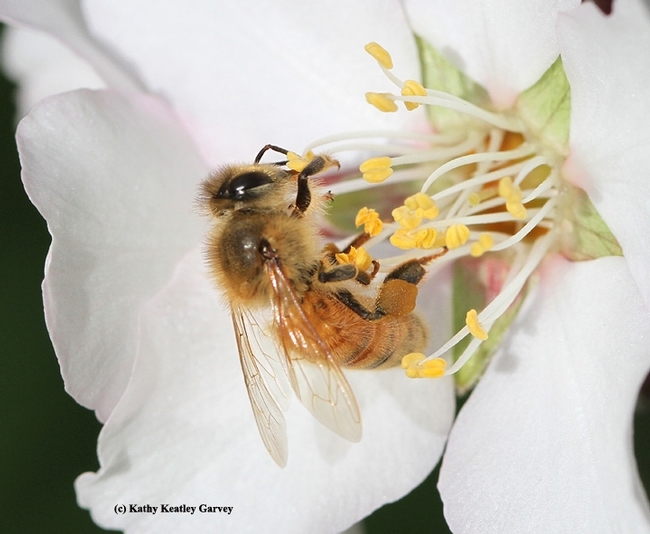
Honey bee pollinating an almond blossom. (Photo by Kathy Keatley Garvey)
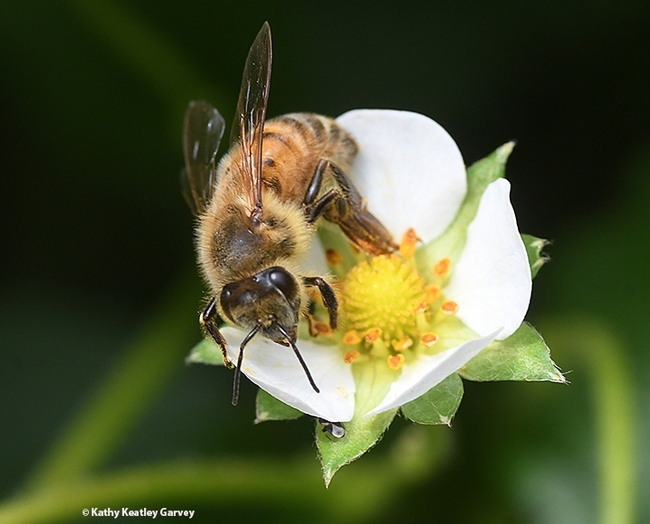
Honey bee pollinating a strawberry blossom. (Photo by Kathy Keatley Garvey)
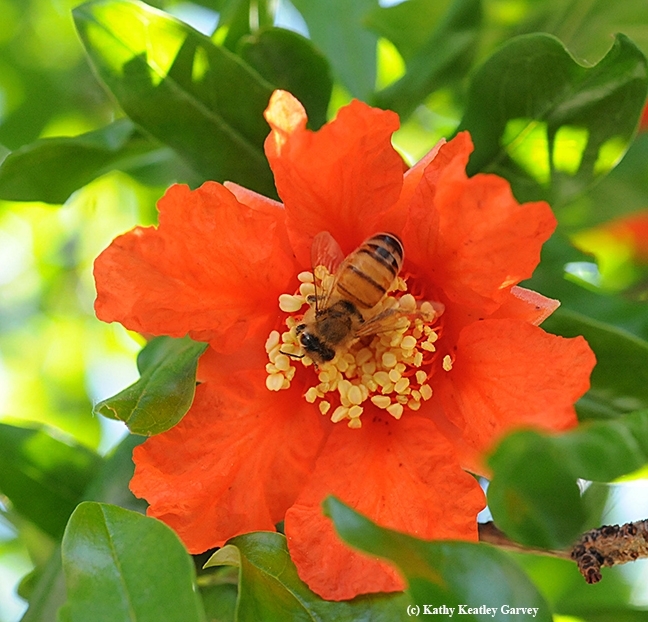
Honey bee pollinating a pomegranate blossom. (Photo by Kathy Keatley Garvey)
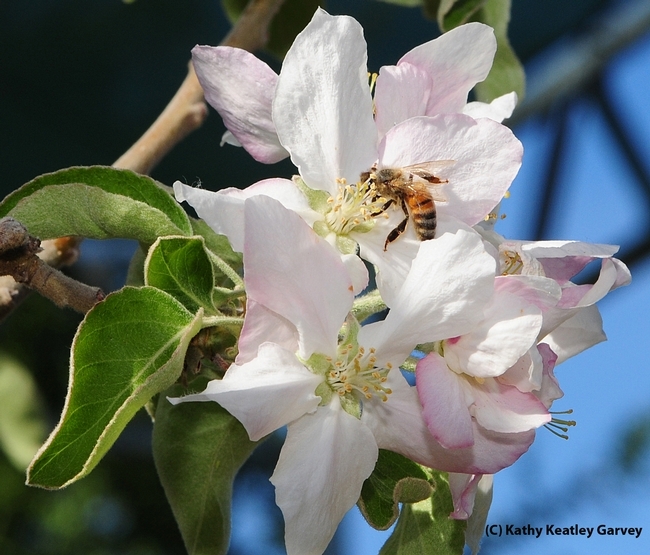
Honey bee pollinating an apple blossom. (Photo by Kathy Keatley Garvey)
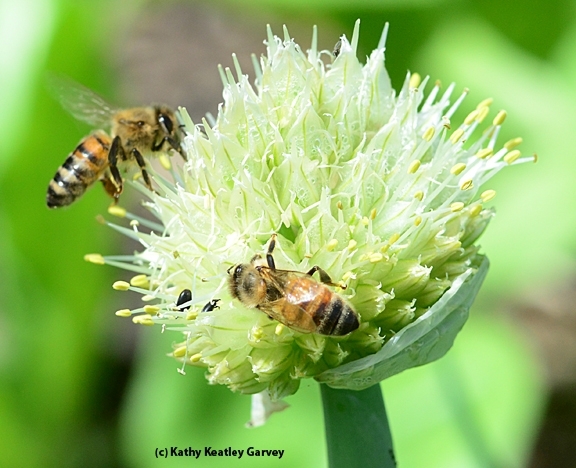
Honey bees pollinating an onion umbel (flowering head). (Photo by Kathy Keatley Garvey)
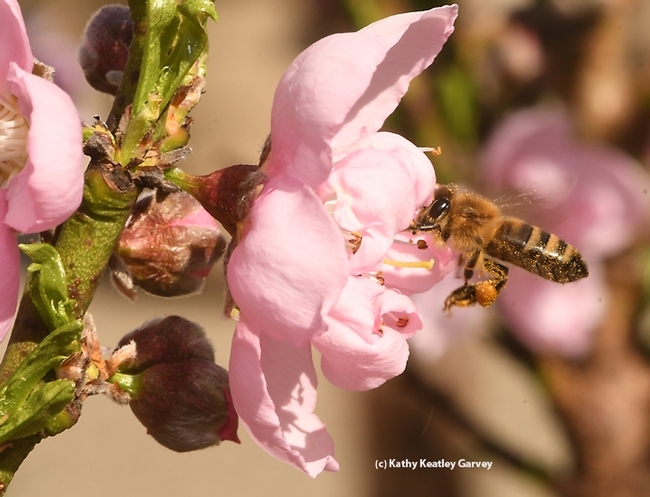
Honey bee pollinating a nectarine blossom. (Photo by Kathy Keatley Garvey)
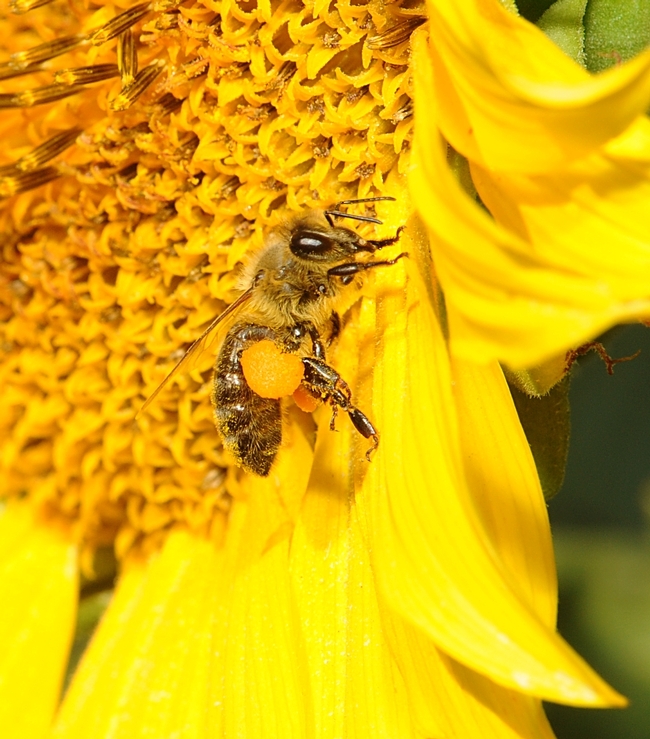
Honey bee pollinating a sunflower blossom. (Photo by Kathy Keatley Garvey)
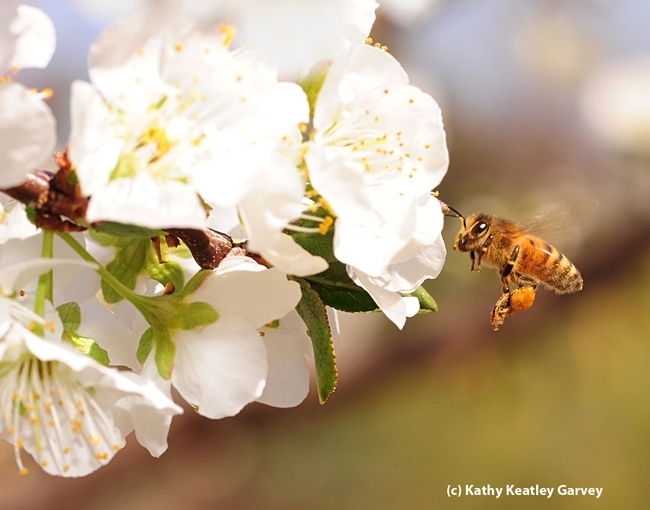
Honey bee heading toward a plum blossom. (Photo by Kathy Keatley Garvey)
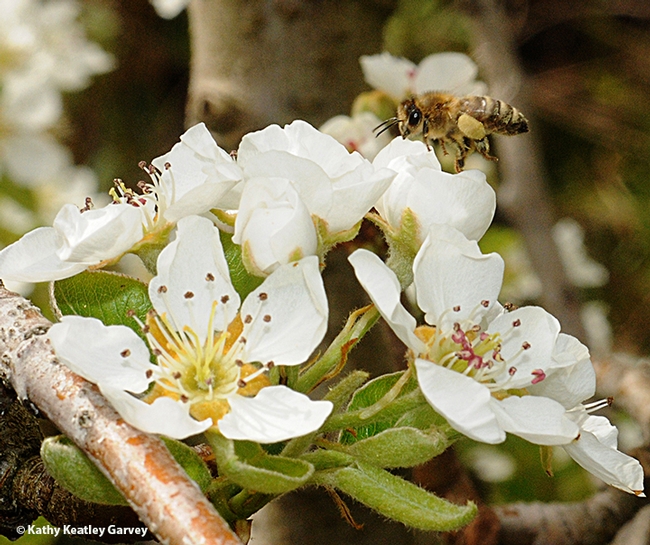
Honey bee pollinating pear blossoms. (Photo by Kathy Keatley Garvey)
Soil health practices show economic and ecological benefits, say farmers
A group of California organic farmers is sharing information about their efforts to combine reduced tillage with the use of cover crops, which they have been planting on their vegetable farms for decades to protect soil while adding carbon and diversity to their production systems.
“Every one of the pioneering farmers has seen tremendous benefits from the practices,” said Jeff Mitchell, UC Cooperative Extension vegetable crops specialist. “These are the very growing practices that we have demonstrated over two decades of research to benefit soil health, environmental conservation and the bottom line on plots near Five Points in Fresno County.”
The organic farmer research project is funded with a Natural Resources Conservation Service Conservation Innovation Grant (CIG) and aims to develop crop production system alternatives for vegetable crops. The farmers are seeing evidence of the ecological benefits, and also benefits that promote the public good.
“Consumers prefer food that is grown in ways that improve soil health as well as environmental health and human health,” Mitchell said. “Farmers must not become obsolete by ignoring ever-evolving buyer demands and environmental imperatives. Make changes, or you'll lose markets.”
The need for California farmers to adjust to changing times was to have been part of the dialogue at a public field day in March at Teixeira & Sons Farm in Firebaugh. It was postponed due to COVID-19 concerns. The event was to showcase Mitchell's data and the experiences of long-time cover crop farmer John Teixeira of Firebaugh.
Teixeira began cover cropping 30 years ago in one of his organic fields. He wanted to build fertility, organic matter and water holding capacity in the soil. Ever since, he's been growing cover crops ahead of tomatoes and several other commodities. This past winter, he grew a mixture of common, hairy and purple vetch, white oats, biomaster peas and bell beans. Teixeira estimates that it provided over 5,000 pounds per acre of dry biomass, which is supporting his 2020 tomato crop with elevated biological activity in the soil.
Mitchell's study in Five Points has tracked impacts of winter cover cropping coupled with no-till since 1999. Over the 21 years, some 37 tons of organic matter, or about 15 tons of carbon, have been added to the soil. These inputs averaged about 3,700 pounds per acre of organic matter, or 0.8 tons of carbon annually. Year-to-year variability has been high, ranging from 8,800 pounds in 2000 when supplemented by irrigation, to 54 pounds in 2007 when, as in most years, the cover crops were grown with rainfall only. Cover crops were typically seeded by Nov. 15 each fall and terminated around March 15.
Several key soil-health indicators improved over the years, including aggregation (or soil structure), porosity and water-holding capacity. Work at the Five Points site conducted by UC Merced professor Teamrat Ghezzehei and Ph.D. student Samuel Araya, has shown 20% higher water-holding capacity in the system with cover crops and no-till compared to the standard bare system.
Earlier results from the study field have shown that when the cover crop and other crop residues are converted to a mulch and left on the soil surface, as much as five inches of water that would normally evaporate during a typical summer crop period stays in the soil.
Mitchell is coordinating the group of organic farmers who are conducting cover crop, tillage and mulch experiments. The farmers cultivate vegetables up and down the Central Valley from Meridian and Guinda in the north, to Dixon, Hollister, Madera, Five Points and Buttonwillow in the south.
“They are an incredible group of people,” Mitchell said. “They have taken soil, farm and human health goals to dramatically important lengths.”
As organic farmers, they have always been in the forefront of soil care and attention to soil biology, Mitchell said, but they're now working together to implement such innovations as virtually year-round soil cover, reduced disturbance tillage, and integration of grazing animals into their fields. Their objective is to enhance the health of their soils, the health of their farms, and the quality of the vegetables that they produce.
Tom Willey, one of the project's farmers from Madera, puts it this way, “What we're attempting to do is up our game on natural systems mimicry on our farms, break through the barrier of over-dependence on tillage in organic systems.”
Eric Brennan, a USDA Agricultural Research Services organic systems horticulturist in Salinas, and integral partner in the effort, has studied cover crops in the Salinas Valley.
“Cover cropping regularly, every winter if possible, is one of the ‘lowest-hanging fruit' practices that vegetable farmers can use to improve soil quality and nutrient management in their production,” Brennan said.
Mitchell believes it's time for broad adoption of practices to promote soil health.
“Everyone used to talk about ‘barriers to adoption' when it came to cover crops. Now the question will more aptly be, ‘What happened to those folks who didn't change and adopt?'” Mitchell said.


